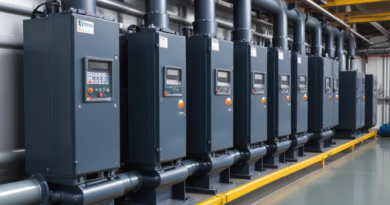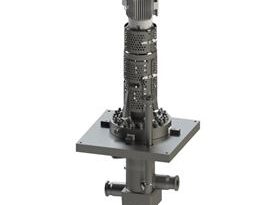how to select a pump for high-purity water
High-purity water is critical in various industries, including pharmaceuticals, electronics, and power generation, where its quality directly impacts product integrity and system performance. Achieving and maintaining the required purity levels involves understanding specific requirements that define high-purity water standards. These requirements typically encompass several key parameters:
- Resistivity: A measure of water’s ability to resist electrical conductivity, indicating the presence of ionic impurities. High-purity water generally exhibits resistivity values greater than 18.2 MΩ·cm.
- Total Organic Carbon (TOC): Represents the concentration of organic compounds, which can affect both the purity and the performance of water-dependent processes.
- Endotoxin Levels: Critical in applications such as pharmaceuticals, where endotoxins can cause adverse biological reactions.
- Particulate Count: The number and size of particles present in the water, which can influence the efficiency and safety of sensitive manufacturing processes.
- Microbiological Contamination: Ensuring the water is free from harmful microorganisms is essential for maintaining overall purity.
Understanding these parameters is essential for the proper selection of high-purity water pumps, as each pump type must meet specific criteria to maintain water quality. The interaction between the pump and the water’s purity requirements dictates the appropriate types of pumps to be used in different scenarios.
| Parameter | Typical Requirement for High-Purity Water | Impact on Pump Selection |
|---|---|---|
| Resistivity | > 18.2 MΩ·cm | Materials must minimize ionic contamination; non-metallic components are often preferred. |
| TOC | < 500 ppb | Pumps must ensure minimal organic leaching from materials used in construction. |
| Endotoxin Levels | < 0.25 EU/mL | Sterilizable pump designs and smooth surfaces to prevent endotoxin accumulation. |
| Particulate Count | < 10 particles/mL (≥ 0.45 μm) | Selection of pumps with seals and bearings that do not generate particulates. |
| Microbiological Contamination | Microbial count < 100 CFU/mL | Use of pumps with antimicrobial properties or designs that inhibit microbial growth. |
In addition to these parameters, the intended application of high-purity water dictates specific operational conditions, such as flow rate, pressure requirements, and temperature ranges. These conditions must align with the capabilities of the high-purity water pumps being considered. For instance, pharmaceutical applications may require pumps that can operate under stringent sterilization protocols, while semiconductor manufacturing might prioritize pumps with ultra-low particle generation.
Moreover, regulatory standards and industry guidelines, such as those from the FDA or ISO, provide frameworks that outline acceptable limits for various contaminants in high-purity water. Adhering to these standards ensures not only compliance but also the reliability and safety of the end products. Therefore, a comprehensive understanding of high-purity water requirements is fundamental to the effective selection and implementation of appropriate pumping solutions.
types of pumps for high-purity applications
When selecting a pump for high-purity water applications, it’s essential to consider the specific types of pumps available, each with unique features tailored to maintain water quality. The primary categories include centrifugal pumps, peristaltic pumps, diaphragm pumps, and magnetic drive pumps. Understanding the characteristics and suitability of each type is crucial for optimal performance and contamination prevention.
Centrifugal Pumps
Centrifugal pumps are widely used due to their ability to handle high flow rates and maintain consistent pressure. They operate by converting rotational kinetic energy to hydrodynamic energy, making them suitable for applications requiring large volumes of high-purity water.
Advantages:
– High Flow Rates: Efficient for large-scale operations.
– Simple Design: Fewer moving parts reduce maintenance needs.
– Cost-Effective: Generally lower initial investment compared to other types.
Disadvantages:
– Potential for Contamination: May introduce particulates if seals and internal components are not properly maintained.
– Less Suitable for Viscous Fluids: Performance can decline with higher viscosity.
Peristaltic Pumps
Peristaltic pumps are ideal for precise dosing and handling sensitive fluids. They operate by compressing a flexible tube, pushing the fluid forward without direct contact with pump internals.
Advantages:
– Contamination-Free Operation: Fluids only contact the tubing, minimizing contamination risks.
– Excellent for Sterile Environments: Easily sterilizable components make them suitable for pharmaceutical and biotech applications.
– Accurate Flow Control: Precise dosing capabilities enhance process accuracy.
Disadvantages:
– Limited Flow Rates: Not ideal for high-volume applications.
– Tube Wear: Regular replacement of tubing is necessary, increasing maintenance efforts.
Diaphragm Pumps
Diaphragm pumps use a flexible diaphragm to move fluids, making them suitable for handling corrosive or abrasive high-purity water.
Advantages:
– Chemical Compatibility: Resistant to a wide range of chemicals, ensuring durability.
– Leak-Free Operation: Positive displacement mechanism reduces the risk of leaks.
– Versatile Applications: Can handle varying viscosities and fluid types.
Disadvantages:
– Flow Pulsation: May require additional filtration to manage pulsating flows.
– Maintenance Intensive: Diaphragms need periodic replacement to maintain performance.
Magnetic Drive Pumps
Magnetic drive pumps eliminate the need for seals by using a magnetic coupling to transfer torque, thereby preventing leakage and contamination.
Advantages:
– Seal-Free Design: Reduces contamination risks and maintenance related to seal wear.
– Highly Reliable: Fewer moving parts enhance longevity and reliability.
– Suitable for Hazardous Fluids: Safe handling of toxic or reactive high-purity water.
Disadvantages:
– Higher Initial Cost: Generally more expensive upfront compared to traditional pump types.
– Limited Availability: Fewer manufacturers specialize in magnetic drive technology.
Comparative Overview
| Pump Type | Flow Rate | Contamination Risk | Maintenance | Best Applications |
|---|---|---|---|---|
| Centrifugal | High | Moderate | Low | Large-scale purification systems, power generation |
| Peristaltic | Low to Moderate | Low | Moderate | Pharmaceutical dosing, biotech processes |
| Diaphragm | Low to Moderate | Low | High | Chemical handling, abrasive fluids |
| Magnetic Drive | Moderate | Very Low | Low | Hazardous fluid management, sterile environments |
Selecting the Appropriate Pump
The selection of the right pump type hinges on several factors, including the required flow rate, the acceptable level of contamination, the maintenance schedule, and the specific application needs. For instance:
– High Flow Rate Needs: Centrifugal pumps are preferred for their efficiency in handling large volumes.
– Sterile and Contamination-Sensitive Environments: Peristaltic and magnetic drive pumps are ideal due to their minimal contamination risks.
– Handling Aggressive Fluids: Diaphragm pumps offer the necessary chemical resistance and durability.
Ultimately, choosing the appropriate high-purity water pump involves balancing these factors to ensure optimal performance, maintain water quality, and meet the stringent standards required in high-purity applications.
material compatibility and construction
Material compatibility and construction are pivotal factors in the selection of high-purity water pumps, as they directly influence the pump’s ability to maintain water quality and prevent contamination. Ensuring that all materials in contact with high-purity water are compatible prevents leaching of impurities and sustains the integrity of the purification process.
- Wettability and Surface Finish: Smooth surfaces reduce points where contaminants can accumulate. Materials with high wettability ensure minimal particulate adherence.
- Chemical Resistance: The pump materials must withstand potential chemical exposures without degrading or reacting, which could introduce contaminants.
- Non-Leaching Properties: Materials should have low tendencies to release ions or organic compounds into the water, maintaining high resistivity and low TOC levels.
- Thermal Stability: Components must endure the operating temperature ranges without compromising structural integrity or purity.
- Compliance with Regulatory Standards: Adherence to standards such as ISO 8573 for air purity or FDA regulations for pharmaceutical applications is essential.
The construction of high-purity water pumps typically involves selecting materials that are inert and non-reactive. Common materials include:
| Component | Common Materials | Advantages |
|---|---|---|
| Impellers | Stainless Steel (e.g., 316L), PVDF, PTFE | Corrosion-resistant, low contamination risk, durable |
| Shafts | Stainless Steel, Hastelloy | High strength, excellent corrosion resistance |
| Seals and O-Rings | Viton, PTFE, EPDM | Chemical resistance, minimal leaching, flexible |
| Casing | Stainless Steel, Titanium | Durable, easy to clean, inert |
| Bearings | Stainless Steel, Ceramic | Reduced contamination risk, long lifespan |
Key Considerations in Material Selection:
- Compatibility with Water Quality: Assess the chemical composition of high-purity water and ensure all materials resist corrosion and do not leach contaminants.
- Manufacturing Precision: High-precision manufacturing techniques ensure tight tolerances and reduce surface roughness, minimizing potential contamination sources.
- Maintenance and Cleaning: Materials should withstand regular cleaning and sterilization processes without degrading.
- Longevity and Durability: Select materials that offer long-term stability to reduce downtime and maintenance costs.
- Cost versus Performance: Balance the initial material costs with the long-term benefits of reduced contamination and maintenance requirements.
In addition to material selection, the overall construction design of high-purity water pumps must facilitate ease of cleaning and maintenance. Features such as accessible seals, minimal crevices, and modular components allow for thorough sanitization and reduce the risk of microbial growth. Utilizing seamless construction techniques and welding methods that prevent crevice formation further enhances the pump’s ability to maintain high-purity standards.
Furthermore, integrating antimicrobial coatings or treatments on wetted surfaces can provide an additional layer of protection against microbiological contamination. The use of gasketing materials that resist biofilm formation is also advantageous in sustaining water purity.
Ultimately, the meticulous selection of materials and thoughtful construction design are essential in ensuring that high-purity water pumps perform reliably without compromising water quality. By prioritizing compatibility and utilizing appropriate construction techniques, these pumps can effectively meet the stringent demands of high-purity water applications across various industries.
contamination prevention strategies
 Effective strategies to prevent contamination are essential in maintaining the integrity of high-purity water systems. Implementing comprehensive contamination prevention measures ensures that high-purity water pumps operate without introducing impurities, thereby sustaining the quality required for sensitive applications. Key strategies include:
Effective strategies to prevent contamination are essential in maintaining the integrity of high-purity water systems. Implementing comprehensive contamination prevention measures ensures that high-purity water pumps operate without introducing impurities, thereby sustaining the quality required for sensitive applications. Key strategies include:
- Sealing Mechanisms: Utilizing advanced sealing technologies, such as double mechanical seals or magnetic bearings, helps prevent the ingress of contaminants. Seals must be compatible with high-purity water to avoid leakage of contaminants from external sources.
- Clean-in-Place (CIP) Compatibility: Designing pumps that support CIP protocols allows for regular and thorough cleaning without disassembly. This reduces the risk of microbial growth and particulate accumulation within the pump.
- Smooth Internal Surfaces: Ensuring that all wetted surfaces are smooth and free of crevices minimizes areas where contaminants can accumulate. Polished surfaces facilitate easier cleaning and reduce the likelihood of biofilm formation.
- Use of Inert Materials: Selecting materials that do not react with high-purity water prevents the introduction of ions or organic compounds. Inert materials also enhance the overall durability and longevity of the pump.
- Antimicrobial Coatings: Applying antimicrobial coatings to internal components can inhibit the growth of microorganisms, further protecting water purity.
- Proper Pump Selection: Choosing the appropriate type of high-purity water pump based on application needs ensures minimal contamination risks. For example, magnetic drive pumps eliminate the need for seals, reducing potential contamination sources.
Contamination Prevention Techniques can be categorized into several key areas:
- Material Selection: Use materials that are non-reactive and do not leach contaminants. Common materials include stainless steel (e.g., 316L), PTFE, and PVDF, which are known for their chemical resistance and low contamination potential.
- Design Optimization: Incorporate design features that reduce dead zones and areas prone to contaminant buildup. Modular designs allow for easy disassembly and cleaning, while minimizing surface roughness helps prevent particulate adhesion.
- Advanced Sealing Solutions: Implement seals that offer high resistance to chemical and microbial penetration. Double seals or seal-less designs, such as magnetic drive pumps, provide additional layers of protection against contamination.
- Filtration Integration: Incorporate inline filters or magnetic separators to capture any particulates or microbial contaminants before they enter the pump system.
- Environmental Controls: Maintain a controlled environment around the pump installation area to limit exposure to airborne contaminants. This includes using cleanroom conditions where necessary and implementing proper ventilation systems.
| Strategy | Implementation | Benefits |
|---|---|---|
| Sealing Mechanisms | Double mechanical seals, magnetic bearings | Prevents contamination ingress, reduces leakage risks |
| CIP Compatibility | Design for easy cleaning without disassembly | Ensures regular sterilization, minimizes microbial growth |
| Smooth Internal Surfaces | Polished and seamless construction | Reduces particulate accumulation, enhances cleanability |
| Inert Materials | Use of stainless steel, PTFE, PVDF | Prevents leaching, ensures chemical resistance |
| Antimicrobial Coatings | Application of specialized coatings on wetted surfaces | Inhibits microbial growth, maintains water purity |
| Pump Selection | Choose suitable high-purity water pump types | Aligns pump performance with contamination prevention needs |
| Filtration Integration | Inline filters, magnetic separators | Captures particulates and microbes before pump entry |
| Environmental Controls | Cleanroom conditions, proper ventilation | Limits exposure to airborne contaminants |
Best Practices for Contamination Prevention include:
- Routine Monitoring: Implement regular testing of water quality parameters such as resistivity, TOC, and microbial counts to detect and address contamination issues promptly.
- Preventive Maintenance: Schedule regular maintenance activities to inspect and replace seals, clean internal components, and verify the integrity of antimicrobial treatments.
- Training and Protocols: Ensure that personnel are trained in proper pump operation, cleaning procedures, and contamination prevention techniques to maintain high standards of water purity.
- Documentation and Compliance: Maintain detailed records of maintenance activities, water quality tests, and contamination prevention measures to comply with industry standards and regulatory requirements.
By integrating these contamination prevention strategies into the selection and operation of high-purity water pumps, organizations can achieve and sustain the necessary water quality for their critical applications. A meticulous approach to contamination control not only safeguards product integrity but also enhances the overall reliability and efficiency of high-purity water systems.
maintenance and reliability considerations
Ensuring the maintenance and reliability of pumps is crucial for sustaining the performance and longevity of high-purity water systems. Regular maintenance routines and a focus on reliability can prevent unexpected downtimes, reduce contamination risks, and extend the operational life of high-purity water pumps. Key considerations in this area include:
- Ease of Maintenance: Pumps should be designed for straightforward access to critical components. Features such as modular assemblies and quick-release fittings facilitate easier inspection, cleaning, and part replacement.
- Availability of Spare Parts: Ensuring that spare parts are readily available minimizes downtime during repairs. Selecting pumps from reputable manufacturers who offer extensive support and readily accessible components is advisable.
- Predictive Maintenance Capabilities: Incorporating sensors and monitoring technologies allows for the early detection of potential issues, enabling proactive maintenance and reducing the likelihood of unexpected failures.
- Operational Reliability: Pumps must consistently perform under specified conditions without frequent breakdowns. High-reliability designs often include redundant systems and fail-safes to maintain operation during component failures.
- Ease of Cleaning: Simplified cleaning processes are essential to prevent contamination. Pumps with smooth surfaces, minimal crevices, and accessible parts are easier to sanitize and maintain.
- Documentation and Support: Comprehensive manuals, maintenance schedules, and technical support from manufacturers aid in effective upkeep and troubleshooting.
Maintenance Best Practices for high-purity water pumps include:
- Regular Inspections: Conduct routine checks of pump components such as seals, bearings, and impellers to identify wear and tear early.
- Scheduled Maintenance: Implement a maintenance schedule that includes lubrication, part replacements, and system calibrations to ensure optimal performance.
- Cleaning Protocols: Utilize Clean-in-Place (CIP) systems to maintain cleanliness without disassembling the pump, reducing labor and contamination risks.
- Monitoring Performance Metrics: Track parameters like flow rate, pressure, and vibration to detect deviations from normal operation, indicating potential issues.
- Staff Training: Ensure that personnel are adequately trained in pump operation, maintenance procedures, and emergency response to enhance system reliability.
Reliability Features to Consider:
| Feature | Description | Benefits |
|---|---|---|
| Redundant Systems | Incorporation of backup pumps or components to take over in case of primary pump failure. | Ensures continuous operation, minimizes downtime. |
| Advanced Sealing Technologies | Use of double mechanical seals or magnetic drives to prevent leaks and contamination. | Enhances contamination prevention, reduces maintenance needs. |
| High-Quality Bearings | Selection of durable bearings that withstand operational stresses. | Increases lifespan, reduces vibration and noise. |
| Corrosion-Resistant Materials | Use of materials like stainless steel or specialty alloys in pump construction. | Prevents material degradation, maintains pump integrity. |
| Integrated Monitoring Systems | Sensors and software that provide real-time data on pump performance. | Facilitates predictive maintenance, enhances operational oversight. |
Selecting Reliable High-Purity Water Pumps involves evaluating the pump’s design, component quality, and support infrastructure. Types of pumps known for their reliability in high-purity applications include magnetic drive pumps, which eliminate seal wear, and centrifugal pumps with robust mechanical seals. Additionally, choosing pumps from manufacturers with a strong track record and offering comprehensive warranties can further assure reliability.
Implementing a comprehensive maintenance strategy alongside selecting reliable pump types ensures that high-purity water systems remain operational, efficient, and free from contamination. Regular upkeep not only preserves pump functionality but also upholds the stringent quality standards required in high-purity water applications across industries such as pharmaceuticals, electronics, and power generation.




